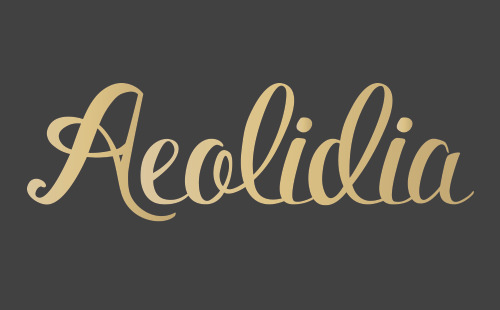
In May 2015, I put together a video presentation for the online Maker Mentors conference. My audience followed along, asked questions via chat, and we got together in the forums after my talk to discuss creating a strong brand story.
To plan my talk, I first wrote a blog post, because I find I am best able to organize my thoughts in writing. I’m sharing that original blog post with you below, or you can watch my full talk on video for free!
My video includes:
- A puppet show! And access to my general goofiness.
- A bonus story about how storytelling saved Aeolidia, my own business
- Additional detail and explanation on topics
Hello! My name is Arianne Foulks. I’m captain and founder at Aeolidia, a graphic and design studio where we have been helping creative folks tell their story and set up shop online for over a decade.
We only work for creative, product-based businesses, and we like products that are unique, well-designed, and full of the maker’s personality.
Over the years, we have watched many businesses succeed, and many more struggle.
Those businesses that seem to have had an overnight success and barely needed to work at promotion? There is something special about them. They know it and their customers know it. Their work can be spotted from a mile off, it’s something that people want, and it’s easy to promote – like a snowball rolling downhill, gathering speed, and getting huge.
Why is it so easy for them? If you have what they have, it will be easy for you, too. If you’re lacking this, it will be like trying to win a race with a bicycle that has square wheels. A crazy amount of work, with few results.
Today we are going to talk about storytelling, brand identity, and how you can make your work into that snowball that only needs a little nudge to get rolling on its own.
Once upon a time, there were two makers

Meet Toby:
He makes soap using a variety of methods. He has been experimenting with metal sculptures, and also brings his handmade kites to the farmer’s market to sell with his soap.
His friends love his soap and have encouraged him to start selling on Etsy. He is giving it a try, and learning how to promote his work, but he is finding it frustrating.
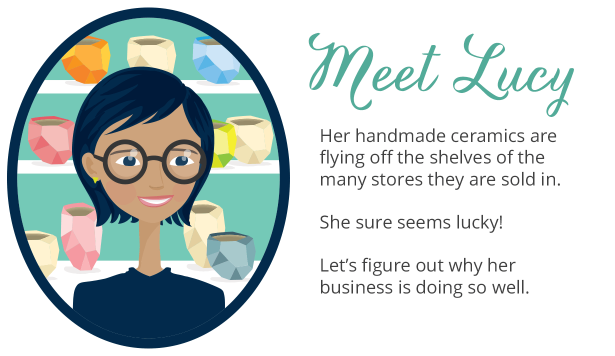
Say hello to Lucy:
She makes handpainted ceramics with geometric shapes and bright colors that are unique to her.
She has been honing her skills as a hobby, and is excited to turn it into a business. Her launch goes well, and she is soon overwhelmed with orders.
After a year in business, both of these entrepreneurs find that they’re having some problems. Which types of problems would you rather have?
Toby has problems:

He feels like he is doing what he is supposed to to market his work, but he isn’t getting any traction. Every marketing effort he makes seems to fall flat.
A friend helped him get a feature on the Etsy blog. Toby felt like this was going to be his big break, and was excited by the new stream of traffic and many new orders to fill. Two weeks after the article was published, everything seemed to go back to how it was, with just a couple of orders each day, and no progress made.
Toby spends a lot of time working on his photography and applies to some juried craft fairs, but is not accepted to any of them. At the farmer’s market, he keeps hearing from people that he’s charging too much for his soap, even though he’s struggling to make a profit at his current price point.
Frustrated, he launches a Kickstarter campaign to fund a new idea for his business. He quietly takes it down a couple of days later, when he sees his only backer is his mom.
Lucy is having some problems, too:

You’ll see that Lucy’s problems are quite a bit more fun.
Her website has been crashing whenever she launches a new product because so many shoppers hit the site at the same time. When she promotes new products, big blogs, and news outlets pick up on the story and sometimes spread it farther than she expects.
She is struggling to keep items in stock, as she has more demand than supply, and can barely keep up with production.
She has been accepted to more fairs and shows than she is able to attend and needs to carefully decide how to divide her time.
It’s hard for her to keep up with all aspects of her business, while she’s juggling publicity, production, and new business prospects.
What is different about these two businesses?
They are both skilled artisans, producing a quality product with love and care. They are both hard workers, taking extra time to learn about running a business and how to market their products. It is working for Lucy, but not for Toby. Let’s talk about where Toby is stuck and what is working well for Lucy.
Toby:

He is not sure what type of person is interested in his product. He thought that with a woodsy scent, he could interest young hipster men in his product, but at the farmer’s market, a mix of people seemed to be purchasing it. No hipsters, but he can’t tell what unites his shoppers and interests them in his soap.
He couldn’t tell you what makes him different from his closest competitor. There are only so many ways to make soap, and if you asked him why you should buy from him instead of Soapy Joe’s down the aisle, he wouldn’t have an answer.
He can’t focus on one thing. He has disconnected product lines and is having a hard time interesting his soap customers in his sculptures, and creating a logo that makes sense for both soap and kites.
His packaging and displays look homemade and he has different graphics, logos, and fonts that he uses in different places. His Etsy shop doesn’t look like his farmer’s market booth, and the packaging is different from item to item.
His products aren’t being featured and sold where his ideal customers are. His soap customers aren’t reading the Etsy blog or shopping the farmer’s market. He’s not sure where they are, since he doesn’t know who they are.
Lucy:

She sure seems lucky! But it turns out that she’s a hard worker with a natural knack for telling her story. Maybe if you asked her how she became an overnight success, she wouldn’t be able to pinpoint the reason, because it comes so naturally to her.
She knows who likes her work and she speaks directly to them where they are hanging out and shopping.
She knows what makes her work different and valuable, and makes sure blog and magazine editors know as well.
Her products make sense together and her logo and packaging tell her story for her when she’s not there to do so.
Because of her storytelling and memorable brand, people want what she sells and they have an easy time sharing it with their friends as well.
Telling your brand story
So you can see why you might want to work on your business’ story.
There are two things you need to figure out first, before working on your full brand story. Work on this, and everything else will be able to roll into place:
1: Discover your Unique Selling Proposition
Your Unique Selling Proposition (or USP), is what makes you different from every other company out there. You should be able to immediately tell someone what makes you different from even your closest competitors.
Aeolidia, for example, designs logos and makes websites. There are gazillions of people who design logos and who make websites. Why is Aeolidia special?
We stand out in these important ways:
Aeolidia is your friendly design team. Customer experience is our top priority, and we pride ourselves on being easy to work with, skipping the jargon, lending a helping hand, and really caring about our clients’ success.
Aeolidia knows creative design-based businesses. Our niche is narrow, so our clients know that we understand what they need and how it should work before we’ve even started talking with them.
No one else knows your creative business as well as we do, has the combined team to help with each stage of the project, or can turn around a full, custom website project as quickly and effectively as we can.
Learn more about finding your USP.
2: Pinpoint your target customer
Even if you feel that your product could be helpful for everyone, you can’t market effectively to everyone. When you sit down in front of a blank page to blog and feel totally stuck, it’s probably because you’re trying to write something that will appeal to everyone.
People buy from you because of how your work makes them feel about themselves. So to do a good job telling your story, you need to know who you’re telling it to. Common practice is to narrow down to one particular person who is your ideal customer, and speak directly to that person in all of your marketing efforts.
For instance, at Aeolidia, we could say that our customer is anyone who needs a website. That is an enormous amount of people, and nowhere near targeted enough. So maybe our customer is a creative business that wants a Shopify website. That is much more narrow, and going down the right path, but is still not specific enough. There is a wide range of businesses that would fit that description, all with different problems, needs, and preferences. We narrowed down to this one person, who is a delightful amalgam of some of our best-fitting, most successful clients over the years.
Our target client started out handmaking every one of the items she designed, and has found a way to scale that feels right for her business. Since then, she has grown rapidly, and has many wholesale accounts. She may have designed a collection for a large chain store, such as Target, Anthropologie, Land of Nod. You can find her products in our favorite brick-and-mortar stores (hello, our other dream client!) all over the country, and can recognize them from a mile away.
She values her own hard work, believes in what she does, is willing to invest money when it makes sense, and knows when to delegate tasks. She wants to increase awareness and sales without letting things get out of her control. She is optimistic, open, and friendly, feeling that similar businesses are more “colleagues” than “competitors.”
She either doesn’t have an ecommerce website, using her current website as informational-only, for retailers who discover her at trade shows. Or she has a simple web shop that she doesn’t promote because it either doesn’t work right, or doesn’t communicate her brand to her customers. Having a great ecommerce site will be an easy extra income stream for her – not only does she have all the processes and resources she needs to manage inventory and ship orders, but the web sales will be more profitable than the traditional 50/50 wholesale split.
So you can see, that is a person who is much easier to talk to than the faceless customer entity.
Learn more about finding your target customer.
Telling a story through your brand
Once you know who your customer is and what is unique about your business, don’t keep it to yourself! You need to make sure that everything you do glows with this, the heart of your brand identity. Examine what you’re showing the world and see if it matches up with what you know about your business.
You can think of your brand identity as the personality of your business. To create a brand for your business, you don’t start with the logo. You start by brainstorming what’s unique about what you do, and putting together a description of your business’ personality which highlights why a customer will want to choose you over others.
Once you know what your business is about, you’ll have an effective starting point for making sure your products, your logo, your marketing materials, and your advertising all make sense with your brand identity.
Does your logo make sense for what your business stands for? Does your website make it clear to your visitors what is different about you? Do your social media interactions, blog posts, and press mentions speak loud and clear to your target audience, instantly letting them know why you’re special and why you’re just what they need?
See some brands that have a great story in the Aeolidia portfolio.
Telling a story with your marketing
Not every business is going to make it. If it was easy, everyone would be doing it, right?
If you take away one thing from today’s talk, remember that storytelling is everything. You don’t want to be a salesman, pushing your products on people who don’t care, but you do want to be a storyteller. How can you apply your story to your marketing?
Show up where you’re welcome and where your customer is as well. Communicate about things your customer is interested in. Be polite and respectful, but don’t hesitate to jump in and be friendly.
Bring something of value every time you show up. Value can be a lot of different things. Entertainment, inspiration, information. Remember to ask yourself before you post what value you are bringing, and your marketing will be instantly improved.
Create things that your customers will naturally want to share. If you’re talking to the right people, the people who will be really into what you do, and you’re creating interesting, valuable blog posts, photos, or products, they will naturally want to share it. If you pitch a big blogger (who has the right audience!) with a friendly email that tells your brand story and shows all your graphic elements working in harmony with that story, she’ll know that her readers will be interested in what you’re sharing, and it will be easy for her to decide to promote your work.
Always remember: why is it interesting, and who would be interested in it?
The huge advantage that small businesses have is their story. What is your story, and how can you communicate it to your customers?
Learn how to pitch your story to the people who will matter most to you.
Want to hire Aeolidia to design a brand identity for your creative business?
We’ve worked with clients like Rifle Paper Co., Emily McDowell, and Handcrafted HoneyBee. You’re in the right place if you have a great product and a growing customer base, but feel held back from reaching the next step for your business. Take a peek at our logo and brand design projects.
Brand Strategy
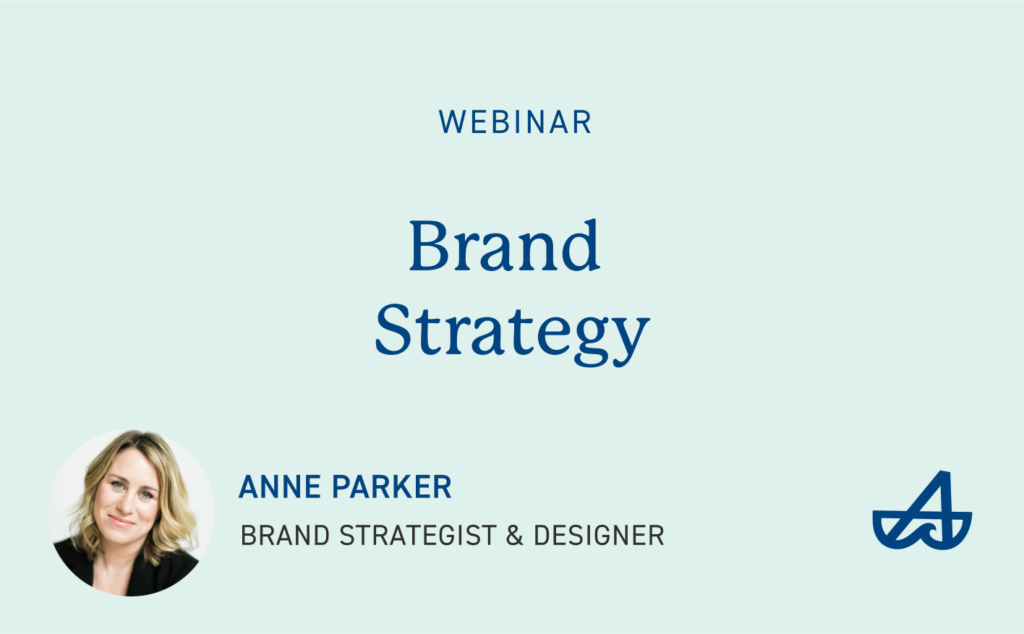
Building a solid, strategic foundation for your brand. With Ann Parker, our brand and web designer and brand strategist.
4 thoughts on “Make Magic for Your Biz With a Strong Brand Story”
Leave a Comment
Related Posts
Let's take your online shop to the next level
The Shopify websites we design have a reputation for substantial improvements to ecommerce conversion rates and online sales. Let's talk!



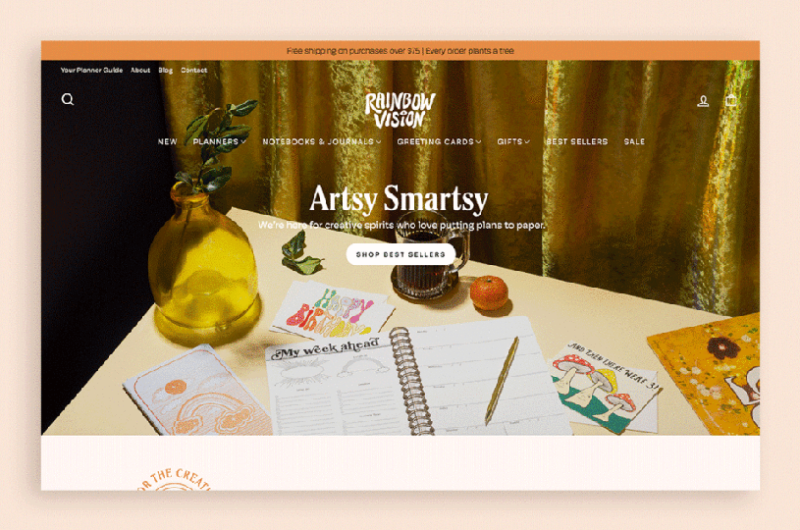











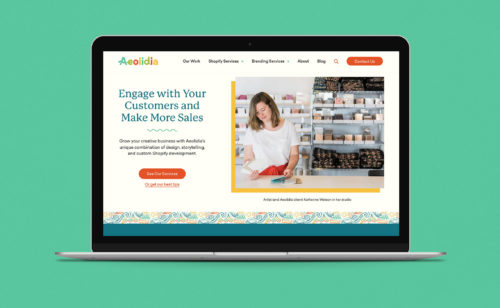
[…] 2. What is truly unique about what you do, and how are you telling your story? It really is all about the story, and I break this down in detail here: Make Magic For Your Biz With a Strong Brand Story […]
[…] 2. What is truly unique about what you do, and how are you telling your story? It really is all about the story, and I break this down in detail here: Make Magic For Your Biz With a Strong Brand Story […]
[…] 2. What is truly unique about what you do, and how are you telling your story? It really is all about the story, and I break this down in detail here: Make Magic For Your Biz With a Strong Brand Story […]
[…] 2. What is truly unique about what you do, and how are you telling your story? It really is all about the story, and I break this down in detail here: Make Magic For Your Biz With a Strong Brand Story […]